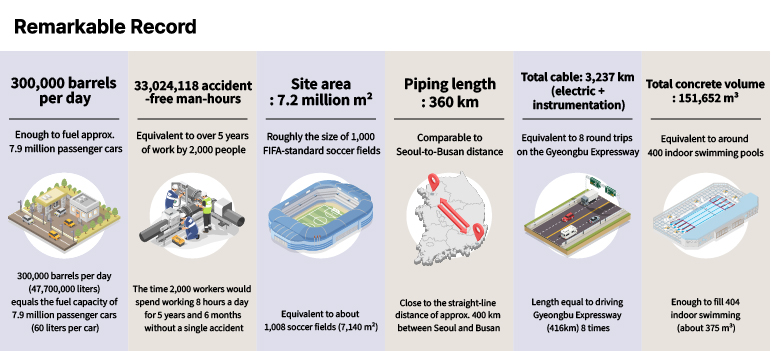
Latest News
- Hyundai E&C Accelerates Energy Transition with Clean Hydrogen Production
- Hyundai E&C Presents Achievements of ‘Hey, Sleep’ Sleep Care Solution at Global Academic Conference
- Hyundai E&C Secures Mega-Scale Seawater Plant Project Worth Approximately KRW 4 Trillion
- Hyundai E&C to Introduce K-Housing in New Zealand
- Hyundai E&C Enters MOU with Leading Australian Energy Network Service Provider “AusNet” to Enter Australian Power Market
Writing a New Chapter on a 40-Year-Old Plant: Saudi Marjan Project
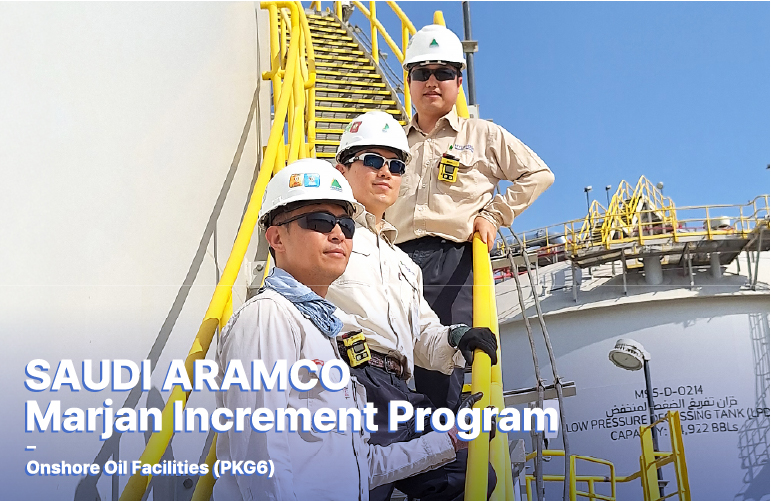
At the heart of the Marjan offshore oilfield, 250 km northwest of Dammam, Saudi Arabia, Hyundai E&C is making history with the construction and expansion of Saudi Arabia’s oil processing facilities. Since breaking ground in June 2019, Hyundai E&C became the first among more than 20 global builders to achieve mechanical completion. With maximum workforce of 5,900 per day, the project recorded an impressive 33 million accident-free man-hours! Behind it all was the passionate teamwork of over 200 partner companies and Hyundai E&C employees. Let’s hear the story of the Marjan Project directly from the people on the ground.
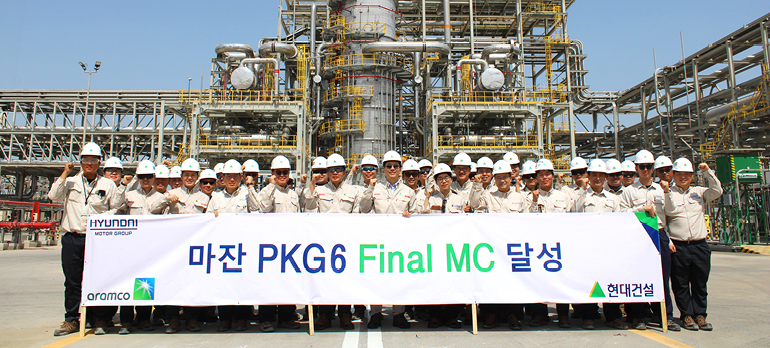
[ During his visit to the Saudi Marjan Onshore Oil Facility (PKG6) on May 12, Hyundai E&C CEO Lee Han-woo congratulated the team on achieving mechanical completion and thanked them for their hard work and dedication ]
Hyundai E&C, First to Achieve Mechanical Completion Among Global Builders in the Marjan Program
Cha Suk-hwan (Cha): What comes to mind first is something our site manager used to say all the time: “Successful project delivery is the key to a company’s competitiveness in winning contracts.”
Although we faced some delays due to the COVID-19 pandemic and global raw material supply disruptions, I take great pride in the fact that we were the first among more than 20 builders in the the Marjan Program to achieve mechanical completion.
Kang Myoung-ho (Kang): Absolutely. There were countless hurdles in building such a large-scale plant from scratch and bare land. But with everyone working hard together, from workers, managers, and even the client, we were able to overcome all the obstacles with ease. I really want to thank everyone who has been on this journey with us for the past six years.
Roh Bong-kyun (Roh): Personally, this project holds special meaning because I was part of it from the very beginning, from detailed design all the way through ground-breaking and final completion. Having seen it through from start to end, I feel a deep and renewed sense of emotion.
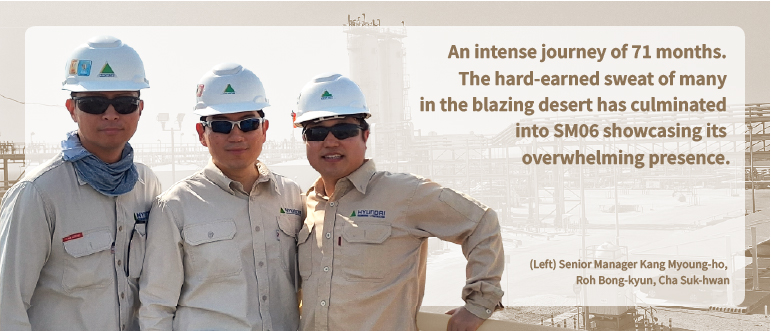
Marjan Reborn: At the Heart of Saudi Arabia’s Oil Expansion Strategy
Cha: Off the northeastern coast of Saudi Arabia, in the waters of the Arabian Gulf, lie several key oil and gas fields including Marjan, Karan, Zuluf, and Safaniya. Among them, the Marjan field has stood as a pillar of steady production of oil and gas for over five decades since its discovery in 1967. In 2017, Saudi Aramco set out to increase its daily output from 12 million to 13 million barrels, and thus three major expansion projects were launched, one of which being the ambitious Marjan increment program.
Roh: More specifically, the “Marjan Increment Program” was Aramco’s first integrated development initiative, bringing together offshore and onshore oil and gas production with water and gas injection facilities into a single project. Hyundai E&C won both Package 6 and Package 12, and our site (PKG 6) specifically aimed to expand the existing plant to process an additional 300,000 barrels of crude oil per day into oil and gas.
Kang: The project comprises three main facilities: the Water Treatment & Injection Plant, which purifies seawater or re-treated water and injects it underground; the Crude Oil Processing Plant, which separates gas from mixed crude oil and removes and stabilizes moisture and salt; and the Gas Processing Plant, which compresses and transports the separated gas. The water injection process involves injecting water at a specified pressure to prevent the natural decline in reservoir pressure during crude oil extraction. The crude oil treatment process filters out impurities and gases from the crude oil and processes it into a state suitable for refining and storage. Finally, the gas processing plant compresses the separated gas and transports it reliably to other facilities. At present, the main plant processes have been completed, and the remaining work includes refurbishing the existing aging facilities and constructing a security facility to ensure the safe operation of the entire expanded plant.

Expansion of 40-Year-Old Existing Facilities... Struggles with the Unpredictable
Cha: Building new facilities on top of an old plant that had been in operation for nearly 40 years presented numerous challenges. Although various maintenance and additional installation works had been carried out over the years, many of these changes were not adequately reflected in the original design documents, leaving certain areas incomplete. To resolve these issues, we used 3D scanning to accurately measure and model the existing facility, incorporating the results into the new design. However, because the underground infrastructure relied solely on outdated blueprints, unexpected obstacles such as hidden cables and pipes continued to surface during construction.
Kang: As a construction manager, the most important thing is to develop a reliable plan and keep everything on track. As you mentioned, our site faced many unpredictable factors, like obstacles that weren’t shown on the drawings and delays in obtaining work permits, so it was difficult to establish a solid plan from the beginning.
Roh: The construction interface was always a challenge, especially when it came to safety management and dealing with complex approvals related to the existing plant. Delays in preparing approval documents or in the issuance of work permits often led to setbacks in both construction and inspections. These issues had to be resolved through close communication with the project management team, and there were frequent arguments with Aramco’s operations team. (Laughs)
Kang: In particular, Aramco construction projects follow their own technical standards, which are much more stringent than typical international specifications. Our site was able to fully comply with those standards and still complete the project on time. I believe this project once again demonstrated Hyundai E&C’s technical excellence.
Roh: Exactly. Working with a very confident and self-assured organization like Aramco requires a great deal of communication and coordination. Technical persistence alone isn’t enough; you also need the ability to propose viable technical alternatives when conflicts of interest arise. In my opinion, the real challenge of working on an Aramco project isn’t just the technical criteria, but the complexity that comes from managing both people and technology. It’s not easy, but the rewards are great. In that sense, this project has been both a tough challenge and a meaningful opportunity for growth.
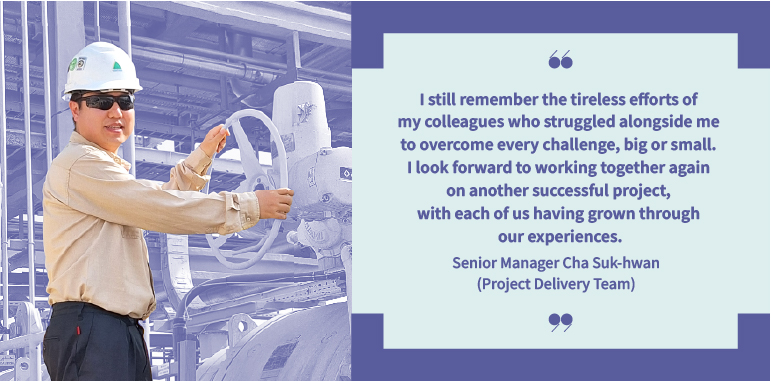
Plants, the Crown Jewel of Total Engineering... Organic Management of 200+ Suppliers is Key
Cha: These days, plant construction projects are increasingly being ordered within compressed timelines, making fast-track delivery essential to meet deadlines. Since design, material procurement, and construction are all closely interconnected, coordination between us and the client, as well as with material suppliers and subcontractors, is critical. On this site alone, we worked with over 200 major material suppliers, hundreds of subcontractors tied to them, and numerous partners involved in design, construction, and commissioning. Integrating their capabilities, managing and motivating them, and addressing countless issues at each point in time were key to the success of the project.
Kang: As a piping construction manager, the water injection facility process left the deepest impression on me because of its complexity. It involved super duplex piping materials, which take longer to weld than standard materials and require highly skilled workers. On top of that, the client demanded a shorter lead time than what is typical for projects of this kind, which added to the challenge. We worked overnight shifts, negotiated with the client to ease certain inspection conditions, and made various efforts to reduce lead time without compromising quality. In the end, we met the client’s expectations and successfully completed the project.
Roh: I remember October 2023, when we were in the middle of constructing the water injection facility. The critical piping that connected to the water injection pumps required welding with super duplex stainless steel. In order to establish a new Welding Procedure Specification (WPS), we had to carry out a Welding Procedure Qualification Test (WPQT). With time running out, we managed to secure the materials and prepare the test specimens, but we kept narrowly missing the threshold needed to pass Aramco’s rigorous standards. As we approached the end of our available specimen material, we took one final shot, and I still vividly remember the tension and excitement in that moment, waiting to find out whether we had passed or failed.
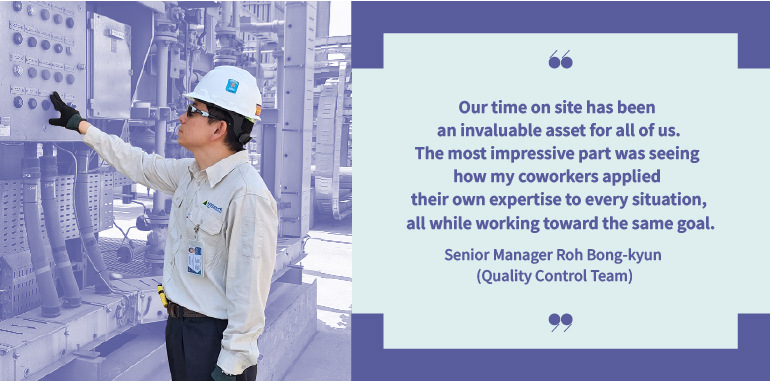
Mastering Both Technology and Safety: Challenge and Growth of Saudi Marjan Package 6
Kang: We also introduced our first Smart Project Control (SPC) program, incorporating Advanced Work Packaging (AWP) construction management techniques. This allowed us to visualize construction activities through 3D models, prepare materials and drawings in advance, and proactively review and coordinate construction interfaces.
Roh: One example is our use of a QR code system for equipment preservation monitoring, which was linked to our construction management system. We had already been using the QR code system for project management, so I casually suggested to the client’s quality manager, “We have this great system, so why not give it a try?” I didn’t expect much, but the response was surprisingly enthusiastic. In the end, we won the Construction Quality Award from Aramco’s Inspection Department. It was a moment that reminded me of the Korean proverb, “It’s not what you have, but how you use it that counts.”
Kang: Thanks to these efforts, our site has now recorded 33 million accident-free man-hours. There has been especially a very high level of interest and commitment to safety across the site. From the outset, all employees took turns patrolling the site at designated times. I firmly believe that safety is never the sole responsibility of the safety department, it can only be achieved through the active participation of every employee. The strong leadership of our site manager played a key role in energizing the entire organization, and as a result, everyone became naturally aware of the importance of safety. That, I believe, is the greatest strength of our site and the key factor behind our accident-free record.
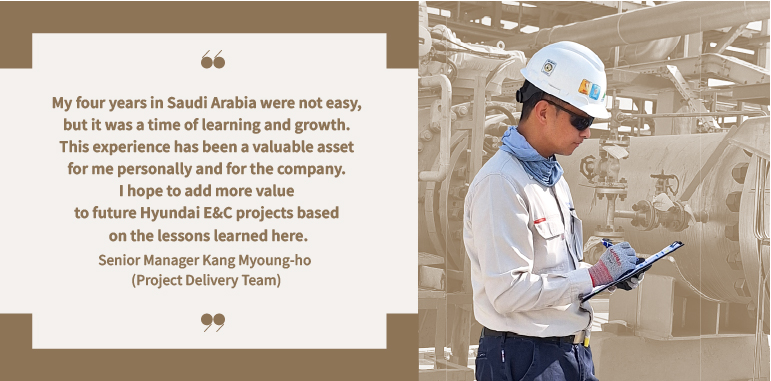
Success Together and a Promise for the Future
Kang: The Marjan Project is a stage where many global construction companies showcase their technology and expertise simultaneously, and I’m proud to say that Hyundai E&C delivered the best performance in terms of execution. When I heard that the client asked a third party to facilitate the process using our site as a benchmark, I was once again reminded of Hyundai E&C’s exceptional standing.
Roh: Above all, Aramco, the client, has no hesitation in choosing Hyundai E&C as a trusted contractor recognized by them. And what better endorsement is there than the recognition of the client? Every day on site was tough and fast-paced, but the time we spent here has become a valuable asset for all of us. What impressed me most was how my coworkers demonstrated their expertise in any situation and worked together toward a common goal. Seeing that, I truly felt that Hyundai is “professional” in every sense of the word.
Kang: Absolutely. Through this project, we didn’t just complete a plant, we showed the world that Hyundai E&C has both the technology and the determination to take on major challenges. I believe the valuable experience we’ve gained on this site will become a strong foundation that empowers us to face even greater challenges ahead.
Cha: Aside from three or four hours a day, I spent nearly all of my 18-hour workdays with my teammates on site. I can still vividly recall how my colleagues faced both small and large problems head-on under the scorching sun and against the fierce coastal winds. Every moment of the Marjan Project (SM06) - the laughter, the struggles, the teamwork we shared over this six-year journey - will remain deeply engraved in each of our hearts. I look forward to seeing everyone again at the next site, as a stronger and more experienced team, ready to take on another successful project together!
